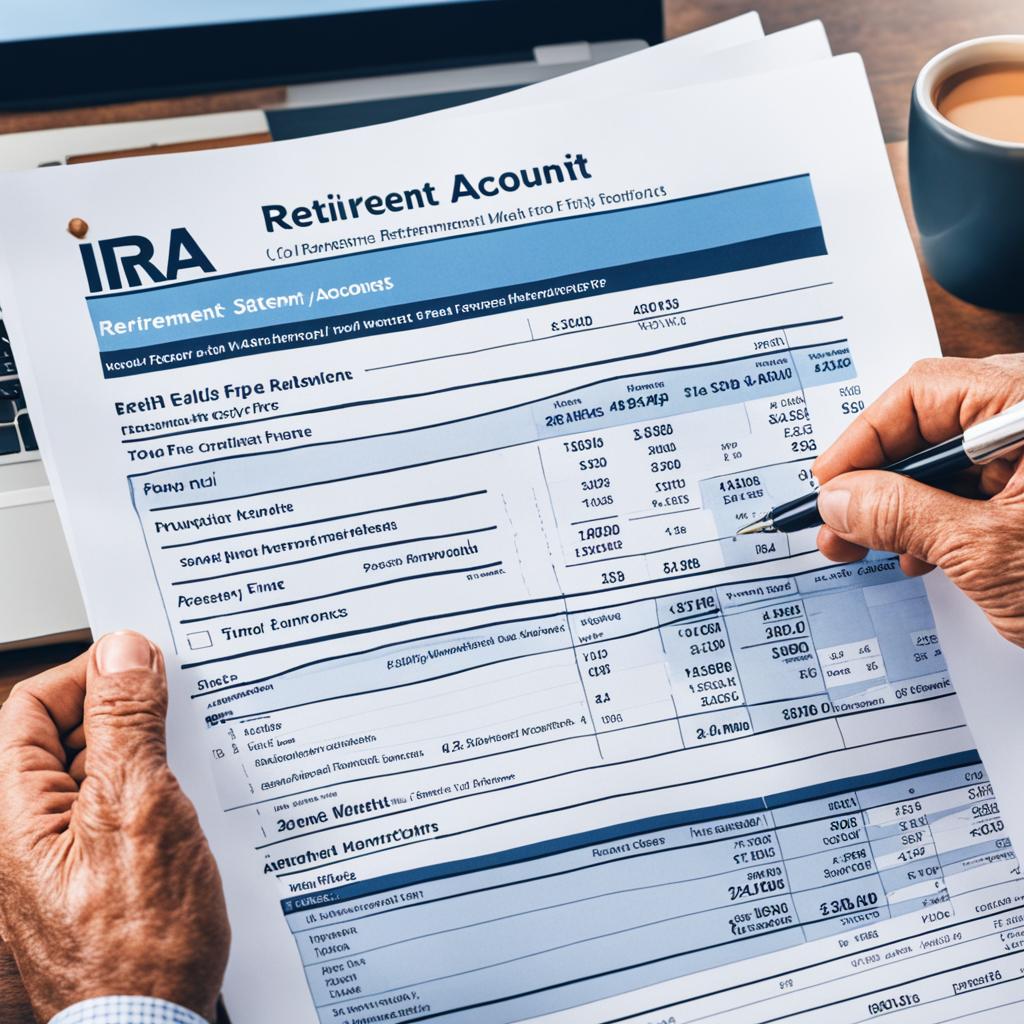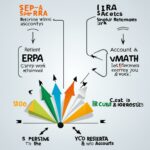An investment account, also known as a brokerage account or securities account, is used by investors to buy and hold securities such as stocks, bonds, and index funds. There are several types of investment accounts available, each with its own purpose. Choosing the right account type is an important decision when setting up an investment account.
Key Takeaways:
- Investment accounts, also known as brokerage accounts, are used to buy and hold securities.
- There are different types of investment accounts, including standard brokerage accounts, retirement accounts, kids investment accounts, education accounts, ABLE accounts, taxable brokerage accounts, employer-sponsored retirement accounts, self-employed retirement accounts, individual retirement accounts, education savings accounts, and health savings accounts.
- Each type of investment account has its own features, benefits, and considerations.
- When choosing an investment account, factors such as financial goals, time horizon, risk tolerance, and tax situation should be taken into account.
- Effective investment account management and planning are essential for long-term success.
Standard Brokerage Account
A standard brokerage account, also referred to as a taxable brokerage account or non-retirement account, provides individuals with the opportunity to invest in a wide range of financial instruments such as stocks, mutual funds, bonds, and exchange-traded funds (ETFs). This account offers flexibility in terms of investment choices, making it a popular option for those looking to grow their wealth outside of retirement or education savings.
Owners of a standard brokerage account have the option to hold the account individually or jointly with another person, allowing for investment strategies to be tailored to specific needs and goals. When opening a brokerage account, individuals can choose between a cash account and a margin account, depending on their investment strategy and risk tolerance.
A cash account requires investors to use their deposited funds for investments, limiting their exposure to the amount they have available. On the other hand, a margin account allows investors to borrow money from the broker to increase their investment potential, providing an opportunity for leveraging investments. However, margin accounts involve higher risk and may require additional qualifications.
To be eligible for a standard brokerage account, individuals must be legal adults and have a Social Security number or tax ID number. Opening a standard brokerage account requires no special qualifications or restrictions, making it accessible to a wide range of investors.
Key Features of a Standard Brokerage Account:
- Access to a wide range of investments, including stocks, mutual funds, bonds, and ETFs
- Flexibility to choose between a cash account and a margin account
- Option to hold the account individually or jointly with another person
- No special eligibility requirements other than being a legal adult
| Pros | Cons |
|---|---|
| Offers flexibility in investment choices | No specific tax advantages |
| Accessible to a wide range of investors | Potential for higher taxes on capital gains |
| Can be used for various financial goals | No contribution limits |
| Potential for higher returns compared to traditional savings accounts | Subject to market fluctuations and investment risks |
Retirement Accounts
Retirement accounts, such as IRAs (Individual Retirement Accounts), are specialized investment accounts designed for retirement savings. They offer tax advantages, such as tax-deferred growth or tax-free withdrawals, depending on the account type (traditional IRA or Roth IRA). Traditional IRAs allow for tax-deductible contributions, while Roth IRAs require after-tax contributions but offer tax-free withdrawals in retirement.
There are also retirement accounts available through employers, such as 401(k) plans, which often include employer matching contributions.
Types of Retirement Accounts:
- Traditional IRA – Allows tax-deductible contributions.
- Roth IRA – Requires after-tax contributions but offers tax-free withdrawals.
- 401(k) plans – Employer-sponsored retirement accounts with potential employer matching.
Investing in a retirement account is a smart financial move for long-term savings and preparing for a comfortable retirement. Let’s take a closer look at the benefits of each type of retirement account:
| Retirement Account Type | Tax Benefits | Key Features |
|---|---|---|
| Traditional IRA | Tax-deductible contributions |
– Contributions may be tax-deductible – Earnings grow tax-deferred – Withdrawals are taxed as ordinary income |
| Roth IRA | Tax-free withdrawals | – Contributions are after-tax – Earnings grow tax-free – Qualified withdrawals are tax-free |
| 401(k) plans | Employer matching | – Contributions may be pre-tax or after-tax – Larger contribution limits compared to IRAs – Potential employer matching contributions |
Kids Investment Accounts
When it comes to securing a bright financial future for our children, investing early can make all the difference. That’s where kids investment accounts come in. These specialized accounts are designed to help parents and guardians start saving and investing for their children’s future expenses, whether it be higher education, a down payment on a house, or any other long-term financial goal.
One popular option for kids investment accounts is a custodial brokerage account. In this type of account, an adult acts as the custodian and manages the investments on behalf of the child until they reach the age of majority. The custodial brokerage account offers a wide range of investment options, including cash, stocks, bonds, and mutual funds, allowing you to create a diversified portfolio that has the potential to grow over time.
Another option to consider is a custodial IRA, which allows children with earned income to contribute to a retirement account. This type of account not only teaches children the importance of saving for the future but also provides them with a head start on building their retirement nest egg. By contributing to a custodial IRA from an early age, children can take advantage of the power of compound interest and potentially accumulate a significant amount of wealth by the time they retire.
Investing in kids investment accounts can be a smart financial move for parents and guardians. Not only does it provide an opportunity to save and invest for their children’s future, but it also teaches them valuable lessons about money management and financial responsibility. By starting early and taking advantage of the power of compounding, parents can give their children a significant head start when it comes to achieving their long-term financial goals.
Remember, when it comes to investing, it’s always important to consult with a financial advisor or do thorough research to ensure that you are making informed decisions that align with your financial goals and risk tolerance.
Education Accounts
When it comes to saving for educational expenses, education accounts offer specific benefits and options. Two popular types of education accounts are the 529 savings plan and the Coverdell Education Savings Account.
The 529 savings plan is a state-sponsored account designed to help individuals save for eligible education expenses, including college tuition. They provide tax advantages, making them an attractive option for many families. A 529 savings plan can be opened directly with the state or through a brokerage.
“A 529 savings plan is a tax-advantaged investment account specifically designed for education savings.”
Another option is the Coverdell Education Savings Account. This account allows for contributions to be used for both college and K-12 expenses. It offers tax advantages similar to the 529 savings plan and can be a valuable tool for parents and guardians looking to save for their child’s education.
Both the 529 savings plan and the Coverdell Education Savings Account have income and annual contribution limits, so it’s important to familiarize yourself with these details before opening an account.
Comparison of 529 Savings Plan and Coverdell Education Savings Account
| 529 Savings Plan | Coverdell Education Savings Account |
|---|---|
| Offered by states | Individual contributions |
| Tax-advantaged | Tax-advantaged |
| Used for college expenses | Used for college and K-12 expenses |
ABLE Accounts
ABLE (Achieving a Better Life Experience) accounts are investment accounts specifically designed for individuals with disabilities. These accounts provide tax advantages and allow individuals to save and invest for disability-related expenses without affecting eligibility for government benefits such as Medicaid.
ABLE accounts function similarly to 529 plans, with tax-deferred growth and tax-free withdrawals for qualified expenses. Eligibility is based on receiving certain benefits or meeting specific disability criteria.
If you or a loved one has a disability, opening an ABLE account can be a valuable financial tool. Here are some key benefits and features of ABLE accounts:
- Tax advantages: Similar to 529 education savings accounts, ABLE accounts offer tax-deferred growth, meaning your investments can grow without being subject to taxes. Additionally, when used for qualified disability expenses, withdrawals from ABLE accounts are tax-free.
- Maintain eligibility for government benefits: One of the main advantages of ABLE accounts is that the funds in the account do not count against the asset and income limits for means-tested government benefits programs, such as Medicaid and Supplemental Security Income (SSI).
- Flexibility in fund allocation: You have the ability to choose how your funds are invested within the ABLE account, allowing you to tailor your investment strategy to your financial goals and risk tolerance.
- Contribution limits: The annual contribution limit for ABLE accounts is subject to the annual gift tax exclusion, which is currently set at $15,000 (2024). However, individuals with disabilities who are employed and not contributing to an employer-sponsored retirement plan may be eligible to contribute an additional amount above the annual limit.
- Qualified disability expenses: ABLE accounts can be used for a wide range of disability-related expenses, including education, transportation, housing, assistive technology, healthcare, and more. The funds in the account can be used to improve the quality of life for individuals with disabilities.
Opening an ABLE account can provide financial security and independence for individuals with disabilities, allowing them to save and invest for future needs without jeopardizing their eligibility for crucial government benefits.
Comparison: ABLE Accounts vs. 529A Accounts
While ABLE accounts and 529A accounts are both designed to benefit individuals with disabilities, there are some key differences between the two:
| ABLE Accounts | 529A Accounts |
|---|---|
| Tax-advantaged savings for disability-related expenses | Tax-advantaged savings for qualified disability expenses |
| Contribution limits based on the annual gift tax exclusion | No contribution limits |
| Withdrawals for qualified disability expenses are tax-free | Withdrawals for qualified disability expenses are tax-free |
| Eligibility requires meeting specific disability criteria | Eligibility requires meeting specific disability criteria |
| Investment options available | Investment options available |
While ABLE accounts offer contribution limits based on the annual gift tax exclusion, 529A accounts do not have contribution limits, allowing for potentially higher savings. However, both account types provide tax advantages and the ability to invest funds for disability-related expenses.

Taxable Brokerage Accounts
When it comes to investment accounts, taxable brokerage accounts offer flexibility and a wide range of investment options. Unlike retirement accounts or education savings accounts, taxable brokerage accounts are not designed for any specific purpose. They allow you to invest your money in various stocks, bonds, mutual funds, and other securities, giving you the freedom to make decisions based on your individual financial goals and preferences.
One of the main advantages of taxable brokerage accounts is the ability to withdraw your money at any time without incurring penalties or restrictions. This makes them ideal for those who may need access to their funds in the short term or want more control over their investments.
There are two main types of taxable brokerage accounts: cash accounts and margin accounts. Cash accounts are the simplest form, allowing you to invest using the funds you have deposited into the account. On the other hand, margin accounts give you the option to borrow money from your broker to potentially increase your investment potential.
The Difference Between Cash Accounts and Margin Accounts
Cash accounts operate on a “pay-as-you-go” basis, meaning you can only invest the amount of money you have available in your account. This type of account provides an added layer of security, as you are not exposed to the risks associated with borrowing money to invest. However, the potential returns may be limited compared to margin accounts.
Margin accounts, on the other hand, offer the opportunity to leverage your investments. With a margin account, you can borrow money from your broker to buy additional securities, potentially amplifying your investment returns if the market performs well. However, it’s important to note that margin accounts come with higher risk, as you are essentially borrowing money to invest. If the market declines, you may be required to repay the borrowed funds even if your investments lose value.
The Benefits of Taxable Brokerage Accounts
While taxable brokerage accounts may not offer the same tax advantages as retirement or education savings accounts, they still come with certain benefits. One of the key advantages is the ability to take advantage of long-term capital gains tax rates. When you hold investments in a taxable brokerage account for more than a year before selling, any resulting capital gains are taxed at a lower rate than short-term capital gains. This can potentially save you money on taxes and increase your after-tax returns.
Additionally, taxable brokerage accounts provide the opportunity for tax-loss harvesting. This strategy involves selling investments that have experienced losses to offset capital gains and potentially reduce your overall tax liability. By strategically managing your investments in a taxable brokerage account, you can generate tax savings that can be reinvested or used for other purposes.
Overall, taxable brokerage accounts offer flexibility, control, and potential tax advantages. They are a valuable tool for individuals looking to grow their wealth and diversify their investment portfolio. Whether you opt for a cash account or a margin account, taxable brokerage accounts provide the opportunity to invest and potentially generate returns without the restrictions of other specialized accounts.
| Advantages | Disadvantages |
|---|---|
|
|
Employer-Sponsored Retirement Accounts
As an employee, one of the key benefits that you may enjoy is the opportunity to participate in employer-sponsored retirement accounts. These accounts, including 401(k)s, 403(b)s, and SEP IRAs, are designed to help you save for your future while providing valuable tax advantages.
Let’s take a closer look at each of these retirement accounts:
401(k) Plans
401(k) plans are retirement accounts offered by private-sector employers. They allow you to contribute a portion of your pre-tax salary, reducing your taxable income in the process. The contributions grow tax-deferred, meaning you won’t pay taxes on them until you withdraw the funds in retirement. Some employers also offer matching contributions, which is essentially free money to help boost your retirement savings. The maximum annual contribution limit for a 401(k) in 2024 is $19,500, with an additional catch-up contribution of $6,500 for individuals aged 50 and older.
403(b) Plans
If you work for a nonprofit organization or a public agency, you may have access to a 403(b) plan. Similar to a 401(k), a 403(b) allows you to contribute a portion of your salary on a pre-tax basis. The contributions grow tax-deferred, and some employers also offer matching contributions. The 2024 maximum contribution limit for a 403(b) is also $19,500, with an additional catch-up contribution of $6,500 for individuals aged 50 and older.
SEP IRAs
For self-employed individuals and small business owners, a SEP IRA can be a valuable retirement savings option. SEP stands for Simplified Employee Pension, and it allows you to make contributions to your retirement account on behalf of yourself and your employees, if applicable. The contributions are tax-deductible, and the earnings grow tax-deferred until withdrawal in retirement. The 2024 maximum contribution limit for a SEP IRA is 25% of your net self-employment income or $58,000, whichever is lower.
Employer-sponsored retirement accounts offer an excellent way to save for your future, with the added benefit of potential employer contributions. These accounts provide tax advantages that can help you grow your retirement savings more effectively.
Here is a comparison table summarizing the key features of each employer-sponsored retirement account:
| Retirement Account | Employer | Annual Contribution Limit (2024) | Matching Contributions |
|---|---|---|---|
| 401(k) | Private-sector employers | $19,500, with $6,500 catch-up contribution for ages 50 and older | May offer matching contributions |
| 403(b) | Nonprofit organizations and public agencies | $19,500, with $6,500 catch-up contribution for ages 50 and older | May offer matching contributions |
| SEP IRA | Self-employed individuals and small business owners | 25% of net self-employment income or $58,000, whichever is lower | No matching contributions |
When considering which retirement account is right for you, it’s important to evaluate your specific circumstances, including your employment status, contribution limits, and the potential for employer matching contributions. Consulting with a financial advisor can help you make informed decisions and maximize your retirement savings potential.
Self-Employed Retirement Accounts
As a self-employed individual, planning for retirement is crucial, and self-employed retirement accounts provide you with the tools to save for your future. The two most common options for self-employed retirement accounts are the solo 401(k) and the SEP IRA.
| Solo 401(k) | SEP IRA |
|---|---|
| Designed for self-employed individuals and their spouses | Available to both self-employed individuals and small business owners |
| Allows for higher contribution limits | Provides tax advantages |
| Functions similarly to a traditional 401(k) plan | Offers flexibility and control over investment decisions |
Both the solo 401(k) and SEP IRA offer tax advantages and allow you to save for retirement on your own terms. The choice between the two depends on your specific needs and financial situation. It may be beneficial to consult with a financial advisor to determine which option is best for you.
Individual Retirement Accounts (IRAs)
When it comes to saving for retirement, Individual Retirement Accounts (IRAs) are an excellent option to consider. These personal investment accounts offer various tax advantages and flexibility to help you secure your financial future.
There are two main types of IRAs available: traditional IRAs and Roth IRAs.
Traditional IRAs
With a traditional IRA, you can make tax-deductible contributions, which means you can potentially lower your taxable income for the year. The earnings in your traditional IRA grow tax-deferred until you withdraw them during retirement, at which point they are subject to income tax. This type of IRA is a great choice if you expect to be in a lower tax bracket during retirement.
Roth IRAs
Roth IRAs, on the other hand, require after-tax contributions, which means your contributions are not tax-deductible. However, the earnings and withdrawals from your Roth IRA are tax-free during retirement, as long as you meet certain requirements. This type of IRA is particularly beneficial if you anticipate being in a higher tax bracket during retirement.
IRA contribution limits vary based on your age and income. As of [current year], the maximum annual contribution is $6,000 for individuals under the age of 50 and $7,000 for individuals aged 50 and older.
One of the advantages of IRAs is that you can open and contribute to them independently, regardless of whether you have an employer-sponsored retirement plan. This makes IRAs an accessible option for self-employed individuals and small business owners.
Here is a comparison between traditional and Roth IRAs:
| Traditional IRA | Roth IRA | |
|---|---|---|
| Tax Treatment | Tax-deferred growth, taxable withdrawals | Tax-free growth, tax-free withdrawals |
| Contribution Tax Deductibility | Contributions may be tax-deductible | Contributions are not tax-deductible |
| Withdrawal Tax Treatment | Taxable withdrawals during retirement | Tax-free withdrawals during retirement |
| Income Eligibility | No income limits to contribute | Income limits for contributions |
| Required Minimum Distributions | Required after age 72 (previously 70 ½) | No required minimum distributions |
Having an IRA is a powerful way to supplement your retirement savings and take advantage of the tax benefits they offer. Keep in mind that IRAs should be part of a comprehensive retirement strategy, and it’s essential to consult with a financial advisor to determine the best approach for your unique situation.

Education Savings Accounts
Educational expenses can be a significant financial consideration, and education savings accounts are specifically designed to help individuals save and invest for these costs. There are two common types of education savings accounts: 529 savings plans and Coverdell Education Savings Accounts (ESAs).
A 529 savings plan is a tax-advantaged investment account that allows individuals to save for qualified education expenses, such as college tuition, books, and room and board. These plans are offered by states and can be opened directly or through a brokerage. Contributions to 529 savings plans grow tax-free, and withdrawals for qualified expenses are also tax-free. The contribution limits for 529 savings plans are set by each state.
A Coverdell ESA, on the other hand, allows for contributions to be used for both college and K-12 expenses. These accounts have income and annual contribution limits, but they offer more investment flexibility compared to 529 savings plans. Contributions to Coverdell ESAs are made with after-tax dollars, but earnings and withdrawals for qualified expenses are tax-free.
Both 529 savings plans and Coverdell ESAs can play a crucial role in helping families save for education expenses and provide tax advantages that help maximize savings. Depending on your specific needs and preferences, one of these education savings accounts could be the right choice for you and your family.
Comparison: 529 Savings Plans vs. Coverdell ESAs
| Aspect | 529 Savings Plans | Coverdell ESAs |
|---|---|---|
| Tax Advantages | Contributions and withdrawals for qualified expenses are tax-free. | Earnings and withdrawals for qualified expenses are tax-free. |
| Qualified Expenses | Primarily used for college tuition and related expenses. | Can be used for both college and K-12 expenses. |
| Investment Flexibility | Investment options are predetermined by the state or program manager. | More investment flexibility with the ability to choose from a wider range of investments. |
| Contribution Limits | Set by each state; typically higher limits compared to Coverdell ESAs. | Annual contribution limit of $2,000 per beneficiary. |
| Ownership | Account owner retains control of the account. | Control is transferred to the designated beneficiary upon reaching the age of majority. |
When deciding between a 529 savings plan and a Coverdell ESA, it’s important to consider your specific education savings goals, income level, and preferences for investment flexibility. Both types of accounts offer unique features and tax advantages that can help you save for educational expenses and provide for the growth of your investments.
Health Savings Accounts (HSAs)
Health Savings Accounts (HSAs) are unique investment accounts that offer individuals a tax-advantaged way to save for qualified medical expenses. These accounts are available to individuals who have a high-deductible health insurance plan, providing them with a powerful tool to manage healthcare costs and save for the future.
Contributions made to HSAs are tax-deductible, meaning they can help reduce your taxable income. This allows you to keep more of your hard-earned money while still saving for medical expenses. Additionally, the investment growth within an HSA is tax-free, meaning your savings can grow over time without being subject to capital gains taxes.
One of the key benefits of an HSA is that qualified withdrawals for medical expenses are tax-free as well. This means that when you use the funds in your HSA to pay for eligible healthcare expenses like doctor’s visits, prescriptions, and even certain medical procedures, you don’t have to pay taxes on that money.
With its triple tax advantage – tax-deductible contributions, tax-free investment growth, and tax-free withdrawals for eligible medical expenses – an HSA offers a powerful way to save money on healthcare costs. It can provide valuable tax savings for individuals and families who have ongoing medical expenses or anticipate future healthcare needs.
By proactively saving and investing in an HSA, individuals can take control of their healthcare expenses and plan for the future. Whether it’s for routine medical costs, unexpected emergencies, or long-term healthcare needs, an HSA can help individuals build a financial safety net and ensure they have funds available when they need them most.
The Benefits of Health Savings Accounts (HSAs)
- Tax advantages: Contributions to an HSA are tax-deductible, and withdrawals for eligible medical expenses are tax-free, offering significant tax savings.
- Flexibility: HSAs offer individuals the flexibility to choose how to use their funds for qualified medical expenses, giving them control over their healthcare finances.
- Investment growth: The funds in an HSA can be invested, allowing them to potentially grow over time and provide even more resources for future healthcare needs.
- Portability: HSAs are portable, meaning individuals can take their account with them if they change jobs or health insurance plans.
Who Can Benefit from Health Savings Accounts (HSAs)
Health Savings Accounts (HSAs) are a valuable tool for individuals who have high-deductible health insurance plans and want to save money on healthcare expenses. They are especially beneficial for:
- Individuals who anticipate ongoing medical expenses and want to set aside money specifically for healthcare costs.
- Young and healthy individuals who want to proactively save for future healthcare needs and build a financial safety net.
- Families with children who have regular medical expenses, such as vaccinations, check-ups, and prescriptions.
- Individuals nearing retirement who want to save for healthcare costs during their golden years.
- Self-employed individuals who are responsible for their own health insurance and want to take advantage of tax savings.

Pros and Cons of Investment Accounts
When considering investment accounts, it’s essential to weigh the advantages and disadvantages of each option. Here’s a breakdown of the pros and cons associated with different types of investment accounts:
Standard Brokerage Accounts
A standard brokerage account offers flexibility and a wide range of investment choices. You have the freedom to invest in stocks, bonds, mutual funds, and more. However, one of the major drawbacks is the lack of tax advantages. Unlike retirement accounts, standard brokerage accounts do not provide tax benefits.
Retirement Accounts
Retirement accounts, such as IRAs and employer-sponsored plans, offer significant tax advantages. Contributions to traditional IRAs are tax-deductible, reducing your current taxable income. Roth IRAs provide tax-free withdrawals in retirement. However, retirement accounts have contribution limits and withdrawal restrictions, making them less flexible for short-term financial needs.
Kids Investment Accounts
Kids investment accounts allow for early savings and investment education. They provide an opportunity to teach children about managing money and building wealth. However, these accounts are subject to custodial control until the child reaches the age of majority. Parents or guardians manage the account on behalf of the child, limiting their control.
Education Accounts
Education accounts, such as 529 savings plans and Coverdell ESAs, offer tax advantages for education expenses. They help individuals save for college tuition and other educational costs. However, utilizing these accounts may affect eligibility for need-based financial aid, as they are considered when determining aid eligibility.
Health Savings Accounts (HSAs)
HSAs provide significant tax advantages for individuals with high-deductible health insurance plans. Contributions to HSAs are tax-deductible, and withdrawals for qualified medical expenses are tax-free. However, HSAs are limited to those with high-deductible health insurance plans, restricting their availability to a specific group of individuals.
| Account Type | Pros | Cons |
|---|---|---|
| Standard Brokerage Accounts | Flexibility in investment choices | No tax advantages |
| Retirement Accounts | Significant tax advantages | Contribution limits and withdrawal restrictions |
| Kids Investment Accounts | Early savings and investment education | Custodial control |
| Education Accounts | Tax advantages for education expenses | Potential impact on student aid eligibility |
| Health Savings Accounts (HSAs) | Tax advantages for medical expenses | Restricted to high-deductible health insurance plans |
It’s important to carefully consider these pros and cons before selecting an investment account. By understanding the benefits and limitations of each type, you can make an informed decision that aligns with your financial goals and circumstances.
Tips for Choosing the Right Investment Account
When it comes to choosing the right investment account, several factors need to be considered to ensure that it aligns with your financial goals, risk tolerance, and tax situation. To make an informed decision, follow these useful tips:
- Determine your financial goals: Clarify what you are saving for and the timeframe in which you will need the funds. Are you saving for a short-term goal, such as a down payment on a house, or a long-term goal, like retirement?
- Assess your risk tolerance: Understand your comfort level with ups and downs in the market. Are you willing to take on higher risk for the potential of higher returns, or do you prefer a more conservative approach?
- Evaluate potential tax advantages: Different account types offer various tax benefits. Consider whether you would benefit from tax-deductible contributions, tax-deferred growth, or tax-free withdrawals.
- Research specific account features: Each type of investment account has its own set of features and benefits. Take the time to research and understand the specifics of each account type to make an educated decision.
- Consult with a financial advisor: Seeking guidance from a financial advisor can provide valuable insights and help navigate the complexities of investment account selection. They can provide personalized advice based on your unique financial situation and goals.
Choosing the Best Account for Your Needs
Table: Comparison of Major Investment Account Types
| Account Type | Tax Advantages | Contribution Limits | Withdrawal Restrictions |
|---|---|---|---|
| Standard Brokerage Account | No tax advantages | No limits | No restrictions |
| Retirement Accounts (IRAs, 401(k)s) | Varies (Tax-deferred growth or tax-free withdrawals) | Contribution limits | Penalties for early withdrawals |
| Kids Investment Accounts | No tax advantages | No limits | Custodial control until legal adulthood |
| Education Accounts (529, Coverdell ESA) | Tax advantages for education expenses | Contribution limits | Usage restrictions for qualified education expenses |
| Health Savings Accounts (HSAs) | Triple tax advantage for medical expenses | Contribution limits | Usage restrictions for qualified medical expenses |

By considering these tips and conducting thorough research, you can make an informed decision when choosing the right investment account. Remember that your choice should align with your long-term financial goals and provide the necessary tools to achieve them.
Investment Account Management and Planning
Once you have chosen the right investment account, it’s important to effectively manage and plan your investments. Investment account management involves regularly reviewing your investment holdings and making adjustments as needed. By keeping a close eye on your portfolio, you can take advantage of market opportunities and mitigate potential risks.
Investment planning goes hand in hand with management. By setting clear goals and creating an investment plan, you can align your investments with your objectives and time horizon. Having a well-defined investment strategy gives you focus and helps you make informed decisions about asset allocation, diversification, and risk tolerance.
One essential aspect of investment management is diversification. Diversifying your investments means spreading your assets across different types of securities and asset classes. This strategy helps reduce the impact of any one investment performing poorly and can potentially enhance returns. By diversifying, you are not putting all your eggs in one basket, which can improve your chances of long-term success.
To effectively manage and plan your investments, it’s crucial to stay informed about market trends and economic conditions. Keeping up with financial news and updates allows you to make informed decisions based on the current market environment. Stay alert to factors such as interest rates, inflation rates, geopolitical events, and industry-specific news that may impact your investments.
Benefits of Regular Monitoring
Regularly monitoring your investment performance and adjusting your strategy when necessary is a critical part of investment account management and planning. Being proactive in reviewing your portfolio can help you identify underperforming investments, rebalance your holdings, and take advantage of new investment opportunities.
| Benefits of Regular Monitoring: | Why It’s Important: |
|---|---|
| Track investment performance | Identify underperforming investments and make informed decisions |
| Rebalance portfolio | Ensure asset allocation aligns with investment objectives and risk tolerance |
| Stay updated on market trends | Make educated decisions based on current market conditions |
| Seize investment opportunities | Take advantage of new investment prospects as they arise |
Remember that investment account management and planning is an ongoing process. Regularly review your investment plan, assess your progress, and make adjustments as needed. It’s advisable to consult with a trusted financial advisor who can provide guidance and help tailor your investment strategy to your specific goals and circumstances.
By effectively managing and planning your investments, you can optimize your portfolio performance, minimize risk, and work toward achieving your financial objectives.
Conclusion
Investment accounts offer individuals a range of options to save and grow their wealth. Whether it’s a standard brokerage account, a retirement account, an education account, or a health savings account, there is an account type to suit various financial goals and needs.
When selecting an investment account, it’s crucial to consider factors such as tax advantages, contribution limits, and available investment options. By carefully planning and managing these accounts, individuals can play an essential role in building wealth and achieving their financial goals.
It’s important to remember that investment accounts are not “one size fits all.” Each account type has its own advantages and disadvantages. From the flexibility of standard brokerage accounts to the tax advantages of retirement accounts and education savings accounts, individuals should choose the account that aligns best with their unique circumstances.
With the right investment account and a well-thought-out strategy, individuals can embark on a journey of financial growth and security. By staying informed, diversifying investments, and regularly reviewing and adjusting their portfolios, individuals can maximize the potential of their investment accounts and pave the way towards a prosperous future.
FAQ
What is an investment account?
An investment account, also known as a brokerage account or securities account, is used by investors to buy and hold securities such as stocks, bonds, and index funds.
What types of investment accounts are available?
There are several types of investment accounts available, including standard brokerage accounts, retirement accounts, kids investment accounts, education accounts, ABLE accounts, taxable brokerage accounts, employer-sponsored retirement accounts, self-employed retirement accounts, individual retirement accounts (IRAs), education savings accounts, and health savings accounts (HSAs).
What is a standard brokerage account?
A standard brokerage account, also referred to as a taxable brokerage account, provides access to a wide range of investments, including stocks, mutual funds, bonds, and exchange-traded funds (ETFs).
What are retirement accounts?
Retirement accounts, such as IRAs (Individual Retirement Accounts) and 401(k) plans, are specialized investment accounts designed for retirement savings and offer tax advantages.
What are kids investment accounts?
Kids investment accounts are designed to help parents and guardians save and invest on behalf of children.
What are education accounts?
Education accounts are specifically designed to save for educational expenses, including 529 savings plans and Coverdell Education Savings Accounts.
What are ABLE accounts?
ABLE (Achieving a Better Life Experience) accounts are investment accounts specifically designed for individuals with disabilities.
What are taxable brokerage accounts?
Taxable brokerage accounts are standard investment accounts that are not specifically designed for retirement or education savings.
What are employer-sponsored retirement accounts?
Employer-sponsored retirement accounts, such as 401(k) and 403(b) plans, are retirement savings plans offered by employers as part of their employee benefits package.
What are self-employed retirement accounts?
Self-employed retirement accounts, such as solo 401(k)s and SEP IRAs, are retirement savings options available to self-employed individuals and small business owners.
What are individual retirement accounts (IRAs)?
Individual Retirement Accounts (IRAs) are personal investment accounts that offer tax advantages for retirement savings.
What are education savings accounts?
Education savings accounts are investment accounts specifically designed to save for educational expenses, including 529 savings plans and Coverdell Education Savings Accounts.
What are health savings accounts (HSAs)?
Health Savings Accounts (HSAs) are investment accounts that allow individuals to save for qualified medical expenses.
What are the pros and cons of investment accounts?
Investment accounts have advantages such as tax advantages, flexibility, and potential growth, but they also have disadvantages such as contribution limits and investment risks.
How do I choose the right investment account?
When choosing the right investment account, consider factors such as your financial goals, time horizon, risk tolerance, and tax situation.
How do I effectively manage and plan my investments?
To effectively manage and plan your investments, regularly review your holdings, consider diversification, set clear goals, stay informed about market trends, and continuously monitor performance.
Our Friends
- https://www.quicken.com/blog/types-of-investment-accounts/
- https://www.nerdwallet.com/article/investing/types-investment-accounts-know
- https://www.forbes.com/advisor/investing/types-of-investment-accounts/
Money posts:
 SEP IRA Contribution Limits for 2024 and 2024
SEP IRA Contribution Limits for 2024 and 2024
 What are the 401(k) Contribution Limits for? (2024)
What are the 401(k) Contribution Limits for? (2024)
 Solo 401k Contribution Limits for 2024 and Beyond
Solo 401k Contribution Limits for 2024 and Beyond
 Tips for Tax-Efficient Investing
Tips for Tax-Efficient Investing
 Roth vs. Traditional IRAs (2024)
Roth vs. Traditional IRAs (2024)
 Solo 401k Rules for Your Self-Employed Retirement Plan (2024)
Solo 401k Rules for Your Self-Employed Retirement Plan (2024)
 Solo 401k Rules for Your Self-Employed Retirement Plan (2024)
Solo 401k Rules for Your Self-Employed Retirement Plan (2024)
 SEP IRA vs Simple IRA – What’s the Difference & Which is Best for You in 2024
SEP IRA vs Simple IRA – What’s the Difference & Which is Best for You in 2024

